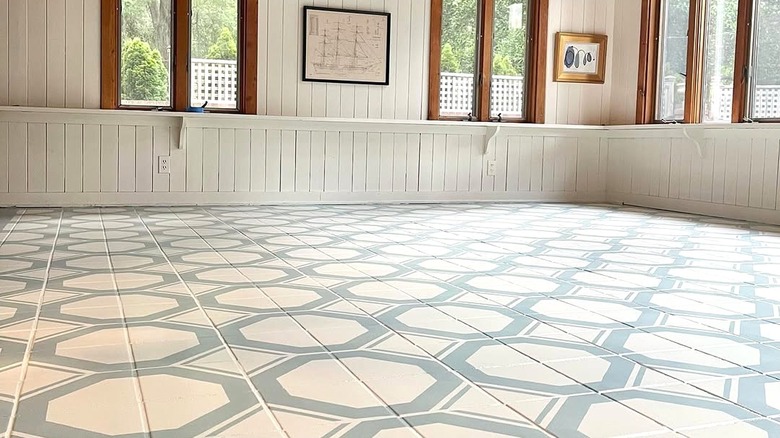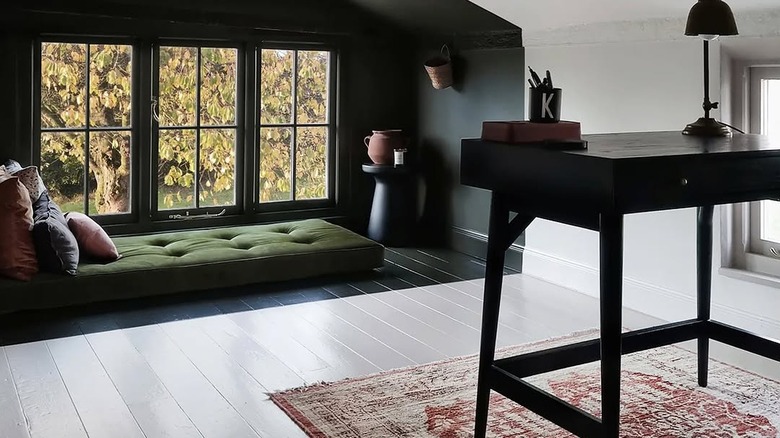The Flooring Trend That You'll Start Seeing Everywhere In 2026 (& How To Get The Look)
When you think about bringing color into a room in interior design, you rarely ever consider the floor. Floors are often seen as a neutral backdrop for bolder design elements like furniture, walls, or even the ceiling. While statement ceilings have become a decor trend in recent years, designers are now looking to the floor to bring unexpected drama and interest to interiors.
Painted floors are one of the flooring trends set to dominate in 2026. They can take on infinite styles, from simple white painted hardwood floors to intricate patterns that resemble tiles and stone inlay. What's great about this trend is that it transforms what is one of the largest areas in any room into a canvas onto which you can express your wildest decor fantasies without breaking the bank. Use painted floors to revive damaged or drab hardwood floors, make an otherwise forgotten room feel more styled and intentional, delineate a certain area in an open space, bring fun and playfulness to a children's room, or replace a rug or runner. The options are endless, and your space will feel uniquely yours.
How to paint different types of floors
Whether you hire a professional or try your hand at a little DIY project, taking every possible step to ensure the durability of your paint job is extra important when you're dealing with floors. These surfaces are exposed to constant foot traffic, as well as stains and abrasions from all kinds of sources. It's crucial to treat the floor properly beforehand. Whether you're painting hardwood, vinyl floors, or concrete floors, they should all be sanded. Wood and concrete often need to be sanded with coarse-grit sandpaper first to remove old finishes and rougher patches before going in with medium-grit and, finally, fine-grit sandpaper to smooth out the surface. Vinyl, on the other hand, only requires fine sanding to get rid of any shine or gloss that can affect the adhesion of the paint. Applying a deglosser also helps with this.
Vacuum and mop thoroughly, allowing the surface to dry completely before moving on. Find primers, paints, and sealants that are not only specific to the material you're working with, but also specific to floors, meaning especially hard-wearing. Epoxy or acrylic-based paints are best suited for concrete floors, while wooden ones require oil-based or latex formulas. Latex is also suitable for vinyl. Paints designed for outdoor projects can also offer great benefits when used indoors, resisting damage caused by moisture and sunlight.
Protect baseboards with painter's tape, and use a foam roller to apply primer, paint, and sealant. A flat brush can help reach awkward edges and corners. If you really want this makeover to last, you must allow enough drying time between coats. If you're unsure, err on the side of caution and give each of them at least 24 hours to settle.
How to incorporate the painted floor trend in your home
Opting for a solid color is a simple way to dip your toe into the painted floor trend. If you love a maximalist aesthetic, paint your floors and walls in contrasting bold colors, like red and blue, or carry an accent color from a playful wallpaper onto the floor. If you prefer a toned-down interior with just a hint of drama, pair light neutral walls and decor with darker, bold floors, and vice versa. You can even use this opportunity to give color drenching a try. Taking the same color from the floor to the wall and up to the ceiling is the painting trend that can boost the tranquility of your room.
If you're ready to commit to something more complex, like a pattern, a good rule of thumb is to look towards the architectural style of your home for inspiration. Classic checkerboard, chevron, or herringbone patterns, as well as more ornate stenciled designs, work well in historic homes. Clean-lined geometric patterns are a better fit for modern spaces. Keep it simple by picking one of the colors in your floor pattern for your walls, or go all out with mismatched patterns in your vertical and horizontal surfaces.
As for scale, the larger the pattern, the more striking it will be, so if you're looking to make a statement with your flooring, that's the way to go. If, however, you don't want to overwhelm the space and prefer using your floors as a fun backdrop for the rest of your decor, small-scale patterns are a better choice. Large central patterns will pop more in rooms with less furniture, while continuous and border designs are best for busy rooms.


